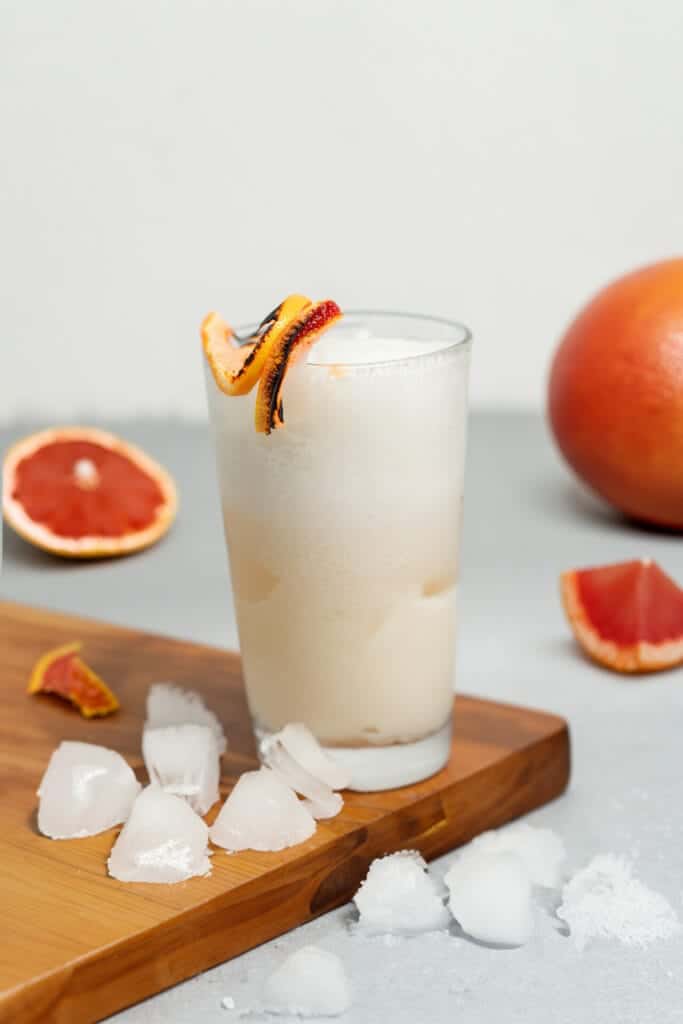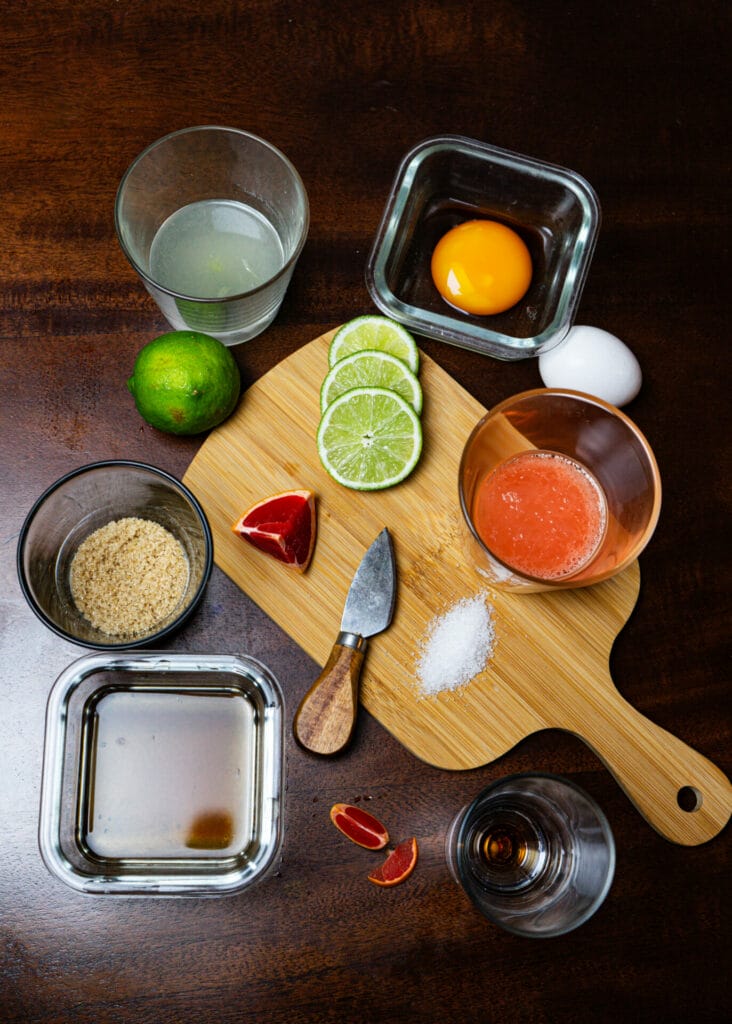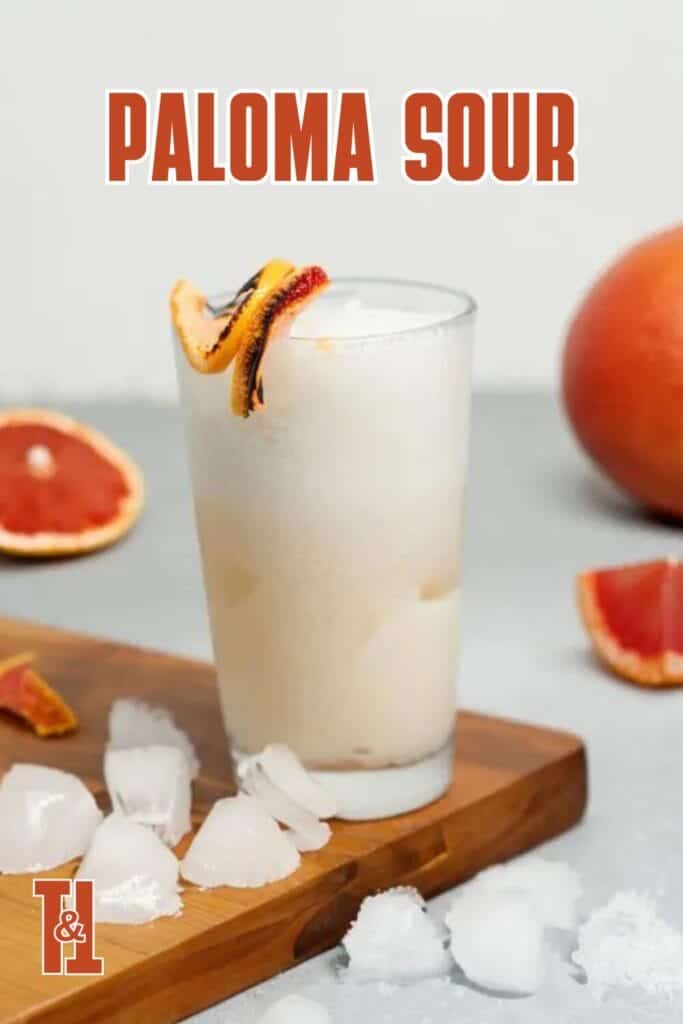The Paloma gets a sour twist for the (you guessed it!) Paloma Sour! Tequila, lime juice, and grapefruit juice form the basis of this sophisticated drink from south of the border.

The jury is out on who created the Paloma, though it’s generally accepted to have been around since the 1860s and named after “La Paloma,” a Mexican folk song, which translates to “the dove” in English. The actual drink is purported to be the work of Don Javier Delgado Corona, the owner of La Capilla in Tequila, Mexico.
Though we’ve covered a number of different versions on the site—the Rosemary Paloma and Spicy Paloma, to name just a couple—the Paloma Sour combines characteristics of two classics—the Paloma and the Whiskey Sour—to create something totally unique.
How Do You Make Simple Syrup?
Simply! Using a ratio of 1:1 (so, equal parts granulated sugar and water), mix together the two ingredients over LOW heat until the sugar granules have all been dissolved. It should now have the consistency of a syrup. That’s all there is to it! Simple syrup is a great way to sweeten your drinks without affecting its consistency too badly. It’s also used for cocktails that require you to muddle ingredients, with the muddling taking place in the syrup at the bottom of the glass. If you don’t want to use white sugar, you can use brown sugar, honey, maple syrup, or agave, in most cases maintaining the 1:1 ratio.
What is the Best Tequila to Use?
First, let’s cover what tequila actually is, then we’ll talk about variations. Tequila is a spirit made from the fermented juices of the blue agave plant. It comes from the Jalisco region, home to the town of Tequila, which is where it gets its name. As for the different types of tequila, they are separated by age. Blanco (silver) is light in color and taste. Because of its mild taste, it mixes well with other ingredients. Reposado is aged in oak casks from two months to a year and bears a slight amber color. Añejo and Extra Añejo (aged and extra aged, respectively) are older, as you might have assumed from their names. Añejo is aged for one to three years, whereas Extra Añejo is kept for periods longer than that. The older the tequila, the richer the taste, typically.

Ingredients
- 2 ounces tequila
- 1 ounce freshly squeezed lime juice
- 1 ounce freshly squeezed grapefruit juice
- 1/2 ounce simple syrup
- 1 egg white
- pinch salt
- grapefruit peel (for garnish)
Instructions
- In a cocktail shaker, combine the tequila, lime juice, grapefruit juice, simple syrup, egg white, and a pinch of salt.
- Shake without ice to help emulsify the egg white (called a "dry shake").
- Fill the shaker with ice and shake again until well chilled and a frothy foam is formed.
- Strain into a glass filled with ice, garnish with a grapefruit peel, and enjoy!
Nutrition
Tips & Tricks to Making a Perfect Paloma Sour Cocktail
- Experiment with the type of tequila you use. I prefer a high-quality silver, though I admit that an older tequila has a more sophisticated taste.
- Use fresh grapefruit and lime juices. The bottled juices at the store contain added sugars and ingredients that, apart from tasting synthetic, aren’t very good for you.
- “Twist” the grapefruit peel by tearing it slightly above the drink, releasing its essence. Then rub it along the glass’s rim. It’s up to you whether you want to hang it off the glass or drop it in the cocktail.
- Shake for at least 30 seconds. It’s integral to the drink that you attain the froth, the chill, and the blend.
- Add a salted rim if you prefer the cocktail to resemble more an original Paloma.
FAQs
Paloma Sour is served in a rocks or Old Fashioned glass, though a highball glass will do nicely. As for garnish, use a wedge/twist of grapefruit and/or lime.
Sour in an airtight container (like a mason jar) and store in the fridge. It should last for a day or so. Give it a proper shake before you drink it again. The foam may suffer from storage so don’t expect it to look as inviting as it once did.
There are typically 205 calories in this recipe. To lower this number, look for a lighter tequila and use fresh juice.
No. If, for whatever reason, you don’t want to use the egg froth, then leave it out, though the cocktail’s resemblance to a Whiskey Sour will be limited.
Yes, replace the egg with chickpea brine (a.k.a., aquafaba). It contains protein and will create a foam if shaken like the egg white.
Carefully crack open an egg into two halves. Over a bowl or a cup, pour the yolk back and forth, from one half of the egg shell to the other. The egg white will drop into the vessel below.
The salt balances out the sweetness and enhances the citrus (similar to how you lick salt and suck on citrus when doing a shot of tequila).
Paloma Sour Cocktail Variations
Sparkling Paloma Sour: Replace the grapefruit juice with grapefruit soda. Or keep the juice and add a splash of cava or another sparkling wine.
Paloma Sour Mocktail: Omit the tequila. You can replace it with more juices, though that’s up to you and your taste buds.
The Paloma: The original, with tequila, grapefruit juice, sparkling water, lime juice, and simple syrup
Rosemary Paloma: Infuse the simple syrup with a sprig of rosemary.
Spicy Paloma: Add a kick to your Paloma with hot sauce and a jalapeno pepper.



Leave a Comment